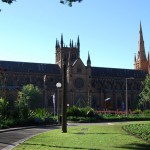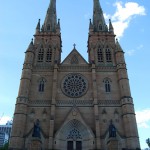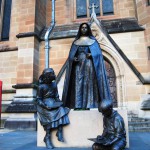Cathedral of Saint Mary in Sydney
The largest city of Australia, Sydney, was founded in 1788 as a penitent colony for the exiled criminals from the British islands. Among them there were many Irishmen, who were unofficially labeled as people of the second class, and with whom you had to be as strict as ever. For committing relatively petty offenses people were sent to do penal servitude in the far away land of Australia that in those days was truly the end of the world. Not a few Irishmen were among the soldiers of the Sydney garrison also. It was the immigrants from Ireland who became the core of the Catholic community in Sydney, which priests John Terry and Philip Connolly soon came to head up. And in 1821, father Terry and the governor of Sydney in those days Lachlan McGuire laid the first stone in the foundation of Saint Mary’s Chapel. Built close to the barracks where the exiled convicts lived, it was a small stone building in Neo-Gothic style.
When in 1835, the first Bishop of New Holland (that is what Australia was called back then), John Polding arrived at Sydney, this modest chapel for the exiled to its own surprise obtained the status of a cathedral. By that time, Sydney was rapidly turning from a piling up of obscure shacks into a blossoming city port. At the middle of the XIX century, the old homely chapel was no longer adequate to match its cathedral status and the new outlook of Sydney as well; and in 1851, English architect Augustus Welby Pugin, an outstanding master of Neo-Gothic style, designed a project to rebuild and enlarge the building. The cathedral, which was reconstructed according to his design, did not exist for too long, on June 29 of 1865, it burned down.
In 1868, Archbishop John Polding blessed the cornerstone of the new cathedral, conceived as the largest temple of the Green Continent. The temple’s project was designed by an English architect William Wilkinson Wardell (1823-1899), Pugin’s disciple. Like Pugin, he was an ardent worshipper of Gothic architecture and member of an intellectual and artistic circle, which was formed around the Earl of Shrewsbury. Having left England at the peak of his very successful career and arriving in Australia in 1855, Wardell took the office of General Inspector of Public Works in Victoria State government. According to his projects, several large buildings were built in Melbourne, including St. Patrick’s Cathedral. In Sydney, Wardell designed the building of St. John’s College at the University of Sydney.
When archbishop Polding invited Wardell to develop the cathedrals’ design, he wrote to the architect, ‘In this matter I leave everything to you and your own inspiration. I would not even mention that your concept should be limited to the Gothic style – any plan, any style, anything that is beautiful and grand, to the extent of our power.” We have to believe that Wardell did not disappoint the archbishop; the cathedral erected by him was indeed “beautiful and grand.”
Almost all of Wardell’s constructions stand out by their huge dimensions, and Sydney Cathedral was no exception. Interestingly enough, according to the original thought of the architect, the building had to be even more grandiose, but it would take huge energy and means to realize such a project. Nevertheless, even in its today’s form St. Mary’s Cathedral looks impressive: it is 107 meters long, its nave’s width is 24.3 meters, nave’s height to the ceiling – 22.5 meters, its tower above the middle crossing is 46.3 meters tall, and towers of the South Front are 74.6 meters tall.
While developing his project, Wardell took the cathedral in Lincoln as the base and made alterations to it in his creative manner. In comparison with the English medieval church constructions, the cathedral of Sydney has its length more emphasized than the width of the Main Front, which makes it similar to the Gothic cathedrals in France. Another distinctive characteristic of Sydney Cathedral is its south-to-north orientation, instead of the traditional west-to-east orientation of Christian temples. It is explained by the fact that Wardell had to fit in his gigantic building into the real dimensions of the site, which put him before a dilemma: either to build a cathedral of a smaller size, or to rearrange the altar in the north direction to keep the building’s grandiosity. Not being willing to discard his plans, Wardell chose the second, non-traditional option. It causes the light to get into the cathedral only through the three windows in the north section of the building, which results in deep shades that reign in the temple’s interior. But early in the morning the cathedral is literally flooded with warm sunlight pouring through the amber glass of fourteen tall lancet windows of the east side. This effect is repeated in late afternoon, when the sun shines through the windows of the west part of the cathedral.
Wardell never saw the fruit of his labour in all of its splendour – he died in 1899, and the construction was finished according to his project by Sydney architecture company “Hennessy and Hennessy.” The north section of the cathedral was dedicated and opened for worship services back in 1882. In 1900, the construction of the central tower over the crossing of the nave and transepts was finished, and in 1905, the main altar of the temple was dedicated. But the works did not stop there – the construction of the central nave continued until 1928. On September 2, the archbishop of Sydney of that time, Michael Kelly solemnly dedicated the cathedral. Its construction eventually took 60 years, the constructions costs amounted to 700 thousand pounds. High spires that top the southern towers, envisaged by Wardell’s project, were built in 1998-2000s, when Sydney was preparing to host the Olympic Games.
The cathedral is built of local stone – Pyrmont sandstone of light-brown colour. Its Neo-Gothic volume recreates the architecture of the great medieval cathedrals of Europe. Small towers hover over the roof with pinnacles and gargoyles-drains, windows and portals are framed with neat pointed arches, the surface of the Main, North Front is decorated with statues of the saints.
The attention of every visitor of the cathedral is caught by the abundance of brightly coloured stained glass windows made in 1881 in England, in the workshops of Birmingham. Multi-coloured stained glass of the north rose-window is devoted to the Biblical subject “The Crowning of St Mary with Heavenly Glory.” In the nave windows, stained glasses with scenes from the New Testament are placed; stained glasses of the first four windows present the story of the Sydney Cathedral’s construction from the moment when the first chapel was founded. Rose-windows in west and east sections of the transept are devoted to Biblical stories of the Old and New Testaments: in the first one, Adam is depicted with Old Testament prophets and patriarchs, in the second – Christ with John the Baptist, Apostles and Evangelists. The stained glass of the south rose-window symbolizes the Church and portrays Saint Peter and sixteen Roman Popes.
The main altar of the temple and altars in the chapels of the Sacred Heart, Saint Joseph, Our Lady and Saint Peter are created according to the drawings of Wardell out of Oamaru limestone from New Zeeland. The altar in the chapel of the Irish Saints is of later origin, and it is created out of the Italian marble. Italian (Carrara) marble served as the material for the copy of the famous sculptural composition by Michelangelo – Pieta, which was placed in the west transept of Sydney’s cathedral in 1971. The baptismal laver in the baptistery, the entrance into which is located in the east section of the nave, is made of Italian marble known as the Royal Siena marble. The real pride of the cathedral are the inlaid mosaic floors that can be seen in the altar section, in the chapels, in the baptistery and in the underground crypt-floor where the tombs of the archbishops of Sydney and the tomb of priest John Terry, the founder of the Sydney Cathedral, are found. Bright coloured floor in the crypt is an outstanding example of the Terrazzo mosaic.
Today St. Mary’s Cathedral is not only a great heritage of the past, but also the organic part of the modern spiritual and cultural life of the city and that of the whole country.
The full name of the cathedral is as follows, the Metropolitan Cathedral of Saint Mary, the Help of Christians. In 2008, the Cathedral was visited by Pope Benedict XVI.
This article uses as its base the article from encyclopedia “The Greatest Temples of the World” – Moscow, Veche Publishing House, 2006.



